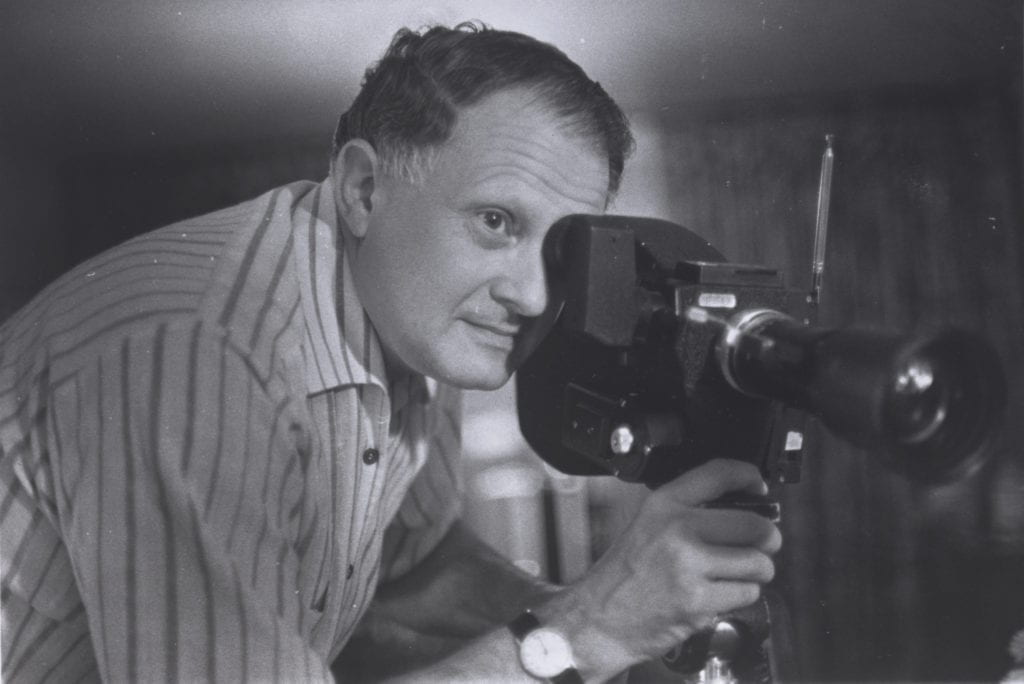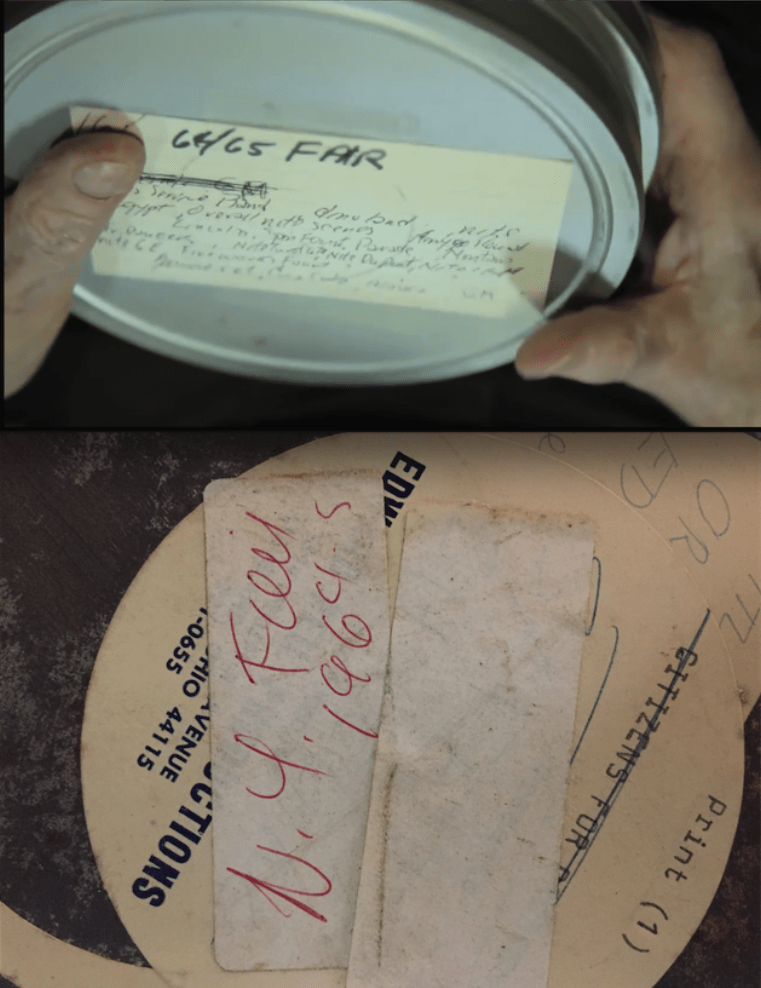Word from Ken Feil today that his father, the great filmmaker Ed Feil, has passed away, age 96. Such a life and career!

Much more can be written about Feil’s scores of films. But for today, we can recommend you watch the exceptional educational melodrama The Inner World of Aphasia (1968). Shot, edited, and directed by Ed, with Naomi Feil playing the lead part.
The Feil family honored us with their presence at a special screening in November 2016. Here are photos from that memorable evening at the Museum of Modern Art, made possible by Katie Trainor and Josh Siegel as well as Rachael Stoeltje and Rob Anen.
Thanks also to Andy Uhrich for sharing IULMIA’s work on the Feil films and publishing these 2016 posts by Rob Anen, who went on to write an NYU MIAP thesis about the Feil Collection. From IU Libraries Moving Image Archive blog:
• “Traveling Around the World with Ed and Naomi Feil,”
• “‘THINK’ing About the Feil Collection and the Importance of Home Movies,”
• “IU’s Carolyn Guss ‘Meets’ Edward Feil in 1956.”
Below the IU video are portions of a blog posting from 2016.
Orphans at MoMA, November 19, 2016
The Inner Whirled of Orphan Films
Part of To Save and Project: The 14th MoMA International Festival of Film Preservation
Combining highlights from NYU’s 10th Orphan Film Symposium and its theme of sound with even newer rediscoveries, this eclectic program of short films is inspired by the creativity and experimentation found among works not made for theaters. “The Inner Whirled” is more than an allusion to the whirling of sound and of film projectors. The word play is also from Ken Jacobs, who called his quartet of short films with Jack Smith The Whirled (1956-63). In 1969, Jacobs and filmmaker Larry Gottheim founded the Department of Cinema at SUNY Binghamton, where an avant garde film culture flourished. (Scott MacDonald wrote a book in 2015: Binghamton Babylon: Voices from the Cinema Department, 1967-1977.) Among the eclectic mix of movies that entered the classroom there was an outlier that captivated Gottheim, the educational film The Inner World of Aphasia (1968), from Cleveland-based Edward Feil Productions.
We’ve just learned that the creative team of Ed and Naomi Feil will make their way from Eugene, Orgeon, to New York for this special screening. Ed began making films in World War II and went on to make dozens of nonfiction films — documentary, educational, scientific, technical, industrial. When he and Naomi married in 1964, they began collaborating on scripts, editing, and soundtracks. She gives a powerful performance as the protagonist of The Inner World of Aphasia.
Katie Trainor (MoMA) & Dan Streible (NYU MIAP)
Welcome & introductions
John Klacsmann (Anthology Film Archives)
“Jiffy” Film: SMPTE P16-PP-C (197?) 5 min.
Produced for the Society of Motion Picture and Television Engineers.
Anthology’s archivist introduces its rare vintage 16mm print of a test film meant to be seen and heard only by projectionists.
James Irsay (WBAI-FM) introduces two films.
Der Bajazzo: Duett der Nedda (ca. 1908) 3 min.
Produced by Deutsche Bioscop, Germany. Vocal by Emilie Herzog and Baptist Hoffmann. Gramophone Monarch Record, 1907.
Restored by DIF – Deutsches Filminstitut, Anke Mebold.
Premier Nocturne en fa # majeur de Chopin, Interprété par Victor Gille (1928)
Produced by Gaumont-Petersen-Poulsen, France. 4 min.
Restored by Cinémathèque Française, Céline Ruivo.
Robert Anen (NYU MIAP) & Rachael Stoeltje (Indiana University Libraries) introduce [NY Fair 1964-1965] home movie filmed by Ed Feil. 11 min. Preserved by Indiana University Libraries Moving Image Archive (IULMIA).
The director of IULMIA and the NYU student-intern explain how the Edward and Naomi Feil Collection came to Indiana in 2016 and how a home movie reel found there helped the Library of Congress reassemble the parts of of a multi-screen Eames production at the World’s Fair.
IULMIA has put even more of the Feil family film online.
George Willeman (Library of Congress) introduces Think (1964) 10 min.
Directed by Ray Eames and Charles Eames for the IBM Pavilion, New York World’s Fair. Reconstructed by Amy Gallick from the Eames Collection.
 |
| Popular Science, July 1964. The Ovoid, where Think was projected and in which Feil filmed some of it in black-and-white 16mm. |
Ken Feil (Emerson College) with special guests Ed & Naomi Feil
The Inner World of Aphasia (1968) 24 min.
Filmed, directed, and edited by Edward R. Feil.
Written by Naomi Feil. Cast: Naomi Feil as Marge Nelson.
Named to the National Film Registry in 2015.
Indiana University Libraries Moving Image Archive.
 |
| End credits. Naomi Feil (right) as nurse Marge Nelson. |
Genevieve Havemeyer-King (New York Public Library; NYU MIAP ’15)
EPH 4/27/16 (1979) 26 min.
Directed by Ephraim Horowitz.
Scanned by Colorlab for Fandor and the NYU Orphan Film Symposium’s Amateur Cinema Project. Named one of the Ten Best amateur productions of 1979.
The 1964-65 New York World’s Fair, constructed at Flushing Meadows Corona Park in Queens, may not have had the cultural impact of the 1939 World’s Fair, but it was a touchstone for many of its 50 million visitors. Thousands shot home movies there, Horowitz as well as Feil. Ephraim Horowitz began his lifelong hobby of filmmaking in the 1930s and shot beautiful color 16mm film at the ’39-40 fair. His movie club friend Richard Post told me recently that Eph lived and worked near the fairgrounds — and therefore frequently lunched there during ’64-65. These World’s Fairs became part of his identity, including that side of him that was a collector of memorabilia. Shots of his collectibles — coins, photographs, films, ephemera — constitute much of EPH 4/27/16. Horowitz also appears in a short documentary: Amanda Murray’s World Fair(2013).
It begins with Horowitz’s 1939-40 footage and him talking in the 2000s. We see Eph at home. Among the objects he lays hands on is a can of 16mm film labeled “64/65 Fair.”
Compare to the label on the can of film Robert Anen saw in the Indiana University archive while processing the Feil Collection this summer. (Here’s that story as told in the New York Times.)

Top: Horowitz’s hands as seen in a frame from Amanda Murray’s World Fair.
Bottom: Snapshot of Ed Feil’s labeled can. ( See Anen’s IULMIA blog post.)
As described in my blog post on Horowitz’s 100th birthday, EPH 4/27/16 caught the interest of we amateur film history researchers and seekers because it was on the filmography “The ‘Ten Best’ Winners, 1930-1994 from the Amateur Cinema League and American International Film & Video Festival,” published in Alan D. Kattelle’s “The Amateur Cinema League and Its Films,” Film History 15, no. 2 (2003). The whereabouts of surviving prints of those more than 600 titles are almost entirely unknown. Seeing a film from the Ten Best list is rare. The blog post of 4/27/2016 also describes Genevieve Havemeyer’s success in tracking down the Horowitz films some three years after her fellow NYU MIAP graduate Kimberly Tarr told me about this unique filmmaker.
As with the 2014 Orphans at MoMA program — An Amateur Cinema League of Nations — this showcase is the culmination of years of collaboration among archivists, curators, scholars, and students dedicated to finding and saving these orphan films. In addition to the students and alumni of NYU’s Moving Image Archiving and Preservation master’s degree program, others who have been working on the history of amateur films include Charles Tepperman, architect of the Amateur Cinema database.
Home movies and amateur films have been part of the Orphan Film Symposium since it began in 1999. As it happens, the Orphans origin story includes a connection to the 1964 New York World’s Fair. The final dinner at the first symposium in took place atop the University of South Carolina’s Capstone House. The dining space called the Top of Carolina is a rotating restaurant with views of the campus and the city of Columbia. It was too novel not to put to use at the conclusion of the four-day soiree. The novelty proved a hit. People began to put notes to one another on the window sill, whose rotation carried them to neighboring tables. Funny, even flirtatious, notes and totems multiplied as the evening went on. The symposium finale returned to this space a couple more times, with some visiting New Yorkers choosing to disbelieve the placard noting that the entire golden rotating restaurant had been moved from its original site in Queens at the 1964-65 World’s Fair.

In 2011, I caught a short glimpse of the rotating restaurant in a home movie shot at the ’64 fair and shown at the Queens Museum during Home Movie Day. Several NYU MIAP students co-organized that event, which transpired during the time when Karan Sheldon (Northeast Historic Film) was working with the museum and George Eastman House on a grant-funded project to document and preserve amateur films shot at the 1939-40 World’s Fair.
Ephraim Horowitz, who passed in 2012, was a long-time member of the Queens Museum [of Art]. And it wouldn’t be surprising if his Flushing fair films wound up in its permanent collection.
— Dan Streible









